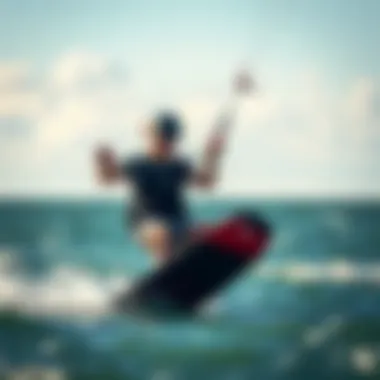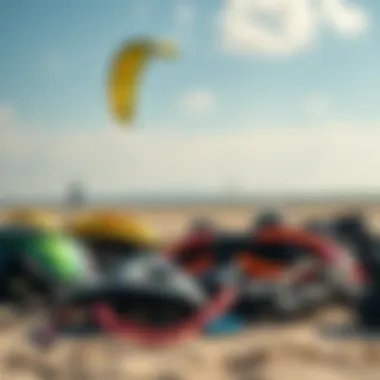Dynamics of Small Kites in Kiteboarding Explained


Intro
Kiteboarding has expanded its wings over the years, evolving from a niche sport into a beloved pastime for many thrill-seekers. Among the various choices available to enthusiasts, small kites have carved their own niche. These kites bring a unique blend of agility, responsiveness, and a bit of challenge to the world of kiteboarding.
Understanding the role of small kites isn't just about their size; it's about harnessing dynamics that can significantly enhance a kiteboarding experience. They offer benefits that become apparent when riders pay heed to certain design features, performance traits, and the very essence of kite selection. If you’re contemplating whether a small kite is suited for your next ride, this article intends to provide a comprehensive insight into their virtues, alongside practical advice.
Whether you're a seasoned rider or just dipping your toes into the waters of kiteboarding, a clear understanding of small kites can make all the difference. This exploration isn't only relevant for those who are already on the waves; novices will find that understanding these dynamics can assist in their learning curve and safety.
So, strap on your harness, and let's navigate through the intricate world of small kites in kiteboarding.
Prelude to Small Kites
In the world of kiteboarding, small kites hold significant value, often overlooked by those new to the sport. Unlike their larger counterparts, these streamlined kites can dramatically change a rider's experience on the water. Understanding the dynamics of small kites is essential for anyone eager to venture into kiteboarding—be it for leisure or competitive aspirations. This section dives into what defines small kites, along with their unique characteristics and the historical journey of their design.
Definition and Characteristics
Small kites are generally recognized by their compact size, typically measuring under ten meters—yet their performance often belies their dimensions. These kites exhibit a few standout features that enhance their appeal among kiteboarders:
- Lightweight Design: Small kites are crafted from lightweight materials such as ripstop nylon, ensuring that they remain buoyant and responsive in various wind conditions.
- Quick Maneuverability: Due to their size, small kites handle considerably faster, allowing riders to execute sharp turns, jumps, and tricks with ease.
- Lower Power Requirements: Smaller kites generate less pull than larger versions, making them ideal for inexperienced riders or those who prefer a more manageable ride.
Their structure also tends to favor stability. A well-designed small kite can hold its shape and perform reliably even in gusty winds, giving riders confidence to push their limits. The key takeaway here is that size is but a number; the experience can be thrilling irrespective of the dimensions.
Historical Context of Kite Design
Tracing the lineage of kite design reveals an evolution shaped by both technological advancements and rider feedback. Smaller kites did not always occupy the spotlight. Traditionally, kiteboarding relied on larger kites, which provided ample lift and power but often at the cost of precision and handling.
In the 1990s, as kiteboarding emerged as a sport in its own right, the conversation began to shift. Designers observed that riders were favoring agility over sheer power. This prompted a wave of innovation, where new materials and aerodynamic shapes were introduced to enhance stability and sustain speed without excessive drag.
Over the years, several key innovations played a role:
- Advanced Fabrics: The introduction of lighter, stronger materials allowed kits to achieve impressive performance without sacrificing durability.
- Canopy Designs: Variations in canopy shapes helped refine lift-to-drag ratios, enhancing flight stability and responsiveness.
- Control Systems: Novel control mechanisms emerged to better harness the dynamics of smaller kites, allowing riders to have finer control.
Today, small kites benefit from the years of refinement that have established their unique niche within kiteboarding. They are no longer an afterthought but rather an essential option for both casual riders and serious kiteboarders seeking exhilarating performance.
"The best kite for a rider is the one that allows them to play and experiment, pushing boundaries while feeling safe and confident."
As we delve deeper into the discussion on kite sizing, performance, and their advantages, it becomes clear that small kites have carved a valuable space. Their growing popularity invites kiteboarders to explore new dimensions in their riding skills.
Understanding Kite Sizes and Their Impact
When it comes to kiteboarding, understanding what size of kite suits your style and the conditions can make all the difference. Kite size isn’t just about the dimensions of the canopy; it impacts performance, handling, and even the experience itself. Getting it right can lead to an exhilarating ride, while choosing poorly can turn a beautiful day on the water into a frustrating endeavor. In this section, we will break down important elements of kite sizing and how they play into the bigger picture of kiteboarding.
The Science of Kite Sizing
Kite sizing is a crucial element that every kiteboarder needs to grasp. The size of the kite—measured in square meters, determines its lift and power. Here’s a rundown on how it influences your ride:
- Power and Control: Larger kites provide more power, making them ideal for lighter wind conditions. Conversely, smaller kites are more suitable for stronger winds as they offer better control.
- Rider Weight: Heavier riders can handle larger kites without being overpowered. Meanwhile, lighter riders should opt for smaller kites to maximize performance without being overpowered. This is particularly vital for those who are just starting out or those who want to fine-tune their skills.
- Wind Window: A kite maneuvers within the "wind window," which is a three-dimensional area where the kite can fly. The size of the kite affects how much of that window can be utilized effectively. Bigger kites fill more of this window but they also require more skill to manage.
- Bar Length: This connects to kite size in how it affects control. A larger kite often pairs better with a longer bar, which gives the rider more leverage, but it can also be more difficult to handle in strong winds.
Understanding these aspects prepares you to select your equipment wisely, matching it to your capabilities and the conditions at hand.
Wind Conditions and Performance
Once you have a sense of kite size, the next layer is understanding how varying wind conditions influence performance. Here's how it breaks down:
- Light Winds (10-15 knots): Smaller kites (around 7-9 square meters) tend to struggle in these light conditions. A medium-sized kite, between 12 to 14 square meters, would perform better, ensuring you harness enough power without being underwhelmed.
- Moderate Winds (15-20 knots): This is where the fun begins for many riders. A smaller kite between 9-11 square meters can efficiently slice through the air, offering excitement and plenty of control.
- Strong Winds (20 knots and above): It's a game changer. Here you've got to be careful. Larger kites might seem tempting, but they can quickly overpower an inexperienced rider. Smaller kites, around 7-9 square meters, will keep you in control while still allowing for thrilling movement.
"Choosing the right kite size is not just about the thrill. It’s about feeling at ease on the water and knowing that you are in control of your ride."
Ultimately, wind conditions require a rider to adapt and use their knowledge of kite sizing. Knowing how wind interacts with kite size allows riders to anticipate their performance and adjust their methods accordingly, ensuring an enjoyable, safe experience on the water.
Advantages of Using Small Kites


When it comes to kiteboarding, the advantages of using small kites are manifold, influencing everything from performance to safety. Understanding these benefits is crucial for anyone looking to enhance their experience on the water. Small kites offer notable agility and can be a game changer, particularly in varied conditions, making them a key asset for both novice and skilled kiteboarders alike.
Enhanced Maneuverability
Small kites are known for their nimble characteristics. Their compact size allows riders to make quick turns and sharp movements, giving them an edge in high-stakes situations. This maneuverability can be particularly advantageous in tight spaces, such as when navigating through crowded zones or making quick adjustments during a jump. The responsive nature of small kites lets riders feel much more connected to the wind and the water. With the right technique, a rider can perform tricks that would otherwise be cumbersome with larger kites.
In terms of practical application, this means:
- More dynamic performances in freestyle disciplines
- Increased ability to adapt to shifting wind conditions
- Heightened excitement during high-speed maneuvers
These factors combined contribute to an experience that is both thrilling and versatile.
Weight Considerations for Riders
The weight of a kite plays a crucial role in overall ride quality. Smaller kites are typically lighter, which translates to several benefits. For one, a lighter kite puts less strain on the rider's body, especially during long sessions. This is particularly important for those who might not have the strength or endurance of professional riders. Additionally, the reduced weight allows for less wind resistance, making it easier to generate lift and speed. In essence, this means less effort is required to stay airborne.
Consider the following:
- A smaller kite requires less energy to control, making it ideal for long sessions.
- Lighter kites are often easier to handle during the launch and landing stages, minimizing potential mishaps.
- They allow lighter riders to engage comfortably with the sport, avoiding the discouraging effects of being overpowered by a larger kite.
Suitability for Beginners
If you’re a newcomer to kiteboarding, gravitating towards small kites may be one of the smartest decisions you make. They provide an excellent learning platform without overwhelming beginners. Their intuitive handling characteristics enable new riders to achieve a level of confidence quicker than with larger kites. Counting the positives, small kites are generally more forgiving during mishaps, reducing the chances of accidents.
Key points include:
- Reduced size translates to a lower risk profile, as beginners are less likely to find themselves in challenging situations.
- Enhanced stability makes it easier to control during takeoff and landing, soothing anxiety for new riders.
- Smaller kites offer a sense of empowerment, allowing beginners to progress faster through their learning curves in various conditions.
Selecting the Right Small Kite
When it comes to kiteboarding, the choice of the right small kite is crucial for both performance and safety. Selecting a kite that aligns with your skill level and style of riding can influence not only how much fun you have out on the water, but also how well you can navigate various conditions. A well-suited small kite enhances your maneuverability and allows you to harness the wind effectively, transforming your kiteboarding experience into something exhilarating.
When pondering over your options, it's important to assess a few key elements that play a significant role in kiteboarding. Knowledge of these factors can prevent poor choices that may lead to frustration, or worse, accidents.
"Choosing the right kite is like finding the right pair of shoes – it should fit perfectly to allow you to soar."
Considerations often include the wind conditions, your level of experience, and the specific type of riding you plan to pursue. Each kite has its own set of dynamics, making it imperative to dive deep into these details.
Key Factors to Consider
- Wind Range: A kite designed for a specific wind range performs optimally only within that range. Make sure to pair your riding style with the appropriate kite size for the wind conditions you usually encounter.
- Skill Level: For newcomers, a smaller kite may be more manageable. On the other hand, experienced riders might look for kites that enhance performance in tricks or high-speed maneuvers.
- Type of Water Conditions: Are you riding on flat, calm waters or in choppy seas? Each environment requires different kite characteristics.
- Personal Preferences: Consider your own riding style. Some riders love speed, while others may prefer floating freestyle maneuvers. A kite's agility will differ based on its design and dimensions.
- Brand Reputation: Stick with brands that have a solid reputation in the kiteboarding community. Reliable products usually come from established manufacturers known for quality.
Recognizing these factors can make the task of selecting a small kite not just easier but also more enjoyable as you envision the time spent riding.
Material and Build Quality
The materials used in constructing a small kite significantly affect its durability and performance. Modern kites are often made with advanced materials that can endure the toughest conditions while ensuring the rider's safety.
- Ripstop Nylon: A popular choice due to its lightweight nature, ensuring easy handling without sacrificing strength.
- Polyester: Offers resistance to the sun's UV rays, which is vital if you plan to spend long hours on the water.
- Bladders: Many small kites incorporate air bladders made from PVC or latex, giving them shape and ensuring they maintain buoyancy even during tumultuous winds.
When assessing build quality, don't shy away from asking experts for recommendations or scouring through reviews. Pay attention to details like stitching and seams; they're the unsung heroes that keep kites intact. Look for kites where patterns and stitching are seamless, as this usually indicates higher quality craftsmanship. In the end, the right kite can be likened to armor, protecting you during your thrilling escapades on the water.
Techniques for Flying Small Kites
When it comes to harnessing the power and dynamics of small kites in kiteboarding, mastery of specific techniques can make all the difference. Flying a small kite isn't merely about holding the lines and letting the wind whisk you away; it's an intricate dance between the rider, the kite, and the ever-changing elements of nature. Understanding these techniques is essential, not just for performance, but for the sheer enjoyment and safety of the sport. With their lighter weight and more nimble movement, small kites present unique challenges that can be adequately met with proper skills and insights.
Basic Control Mechanisms
Controlling a small kite effectively begins with understanding the basic mechanisms that govern its flight. Unlike larger kites, which exhibit more stable characteristics, small kites are extraordinarily sensitive to inputs, making smooth controls critical. Here are fundamental aspects to keep in mind:
- The Bar and Lines: Maintaining consistent tension on the lines is vital. A taut line helps the kite keep its shape and direction. Experimenting with the position of the bar can alter the kite’s angle of attack and responsiveness.
- Using Body Weight: Shifting your weight can direct the kite. Leaning towards the kite will bring it lower in the wind window, while leaning back can lift it higher. This technique allows you to maneuver swiftly and efficiently.
- Wind Awareness: The kite's behavior is significantly influenced by wind. Get accustomed to how different gusts affect your control. For instance, a sudden increase in wind speed can cause the kite to rise quickly if not managed carefully.


Understanding these basic controls not only enhances your riding experience but also ensures safety against unexpected shifts in wind.
Advanced Maneuvers and Tricks
Once the basics are mastered, the real fun lies in exploring advanced maneuvers and tricks. Small kites allow for impressive agility, enabling experienced riders to pull off tricks that would be harder with larger models. Here are some advanced techniques worth considering:
- Jumping: Small kites excel in generating lift, which is crucial for jumps. Initiate a jump by loading the edge of the board and then popping off the water while steering the kite upward. Timing your pop with the kite's lift can result in some spectacular airborne moments.
- Downlooping: An exciting trick involves steering the kite in a quick circular motion while descending from a jump. This maneuver requires precise timing and control but can result in an exhilarating boost of speed and height.
- Handle Pass: This trick showcases not only control but also style. Transfer the bar behind your back while in mid-air. It demands a good mastery of body positioning and kite control to execute smoothly.
Mastering techniques not only elevates your kiteboarding experience but also expands the range of tricks that can be performed effortlessly. The synergy between rider skill and kite responsiveness is key to unlocking the potential small kites present in the vast kiteboarding landscape.
Safety Considerations When Using Small Kites
When it comes to kiteboarding, safety is the name of the game. Using small kites can bring a range of exhilarating experiences, but they also come with their own set of risks. Understanding and preparing for these risks helps ensure that both the ride and the surroundings remain safe.
Riders need to be aware of the potential hazards present in the environment and understand how to manage these effectively. This section emphasizes the importance of being cautious and well-prepared, aligning perfectly with the dynamic nature of kiteboarding.
Essential Safety Gear
Having the right gear can make a world of difference in kiteboarding, especially with smaller kites. While the kites may be lightweight and easy to handle, riders must not skimp on safety equipment. Here are essential safety items to consider:
- Safety Harness: A good quality harness provides support and helps distribute the pull from the kite effectively, reducing strain on the body.
- Helmet: Protecting your head is crucial. A well-fitted helmet guards against impacts from falls or collisions.
- Impact Vest: This helps cushion falls and offers additional support.
- Quick Release System: Ensures that the rider can easily detach from the kite in an emergency.
- Leash System: Keeps the kite connected to the rider safely and prevents it from being lost in the water.
- Life Jacket: Depending on the conditions, having a life jacket can be a life-saver, particularly in rough waters.
It's also wise to consider the kite's safety features and ensure they are fully operational before hitting the water. Regular checks can mean the difference between a thrilling adventure and a disastrous situation.
Understanding Environmental Hazards
Riding in the great outdoors comes with unpredictable elements that can pose risks to kiteboarders. Being aware of environmental hazards is crucial:
- Wind Conditions: Weather can change rapidly. It's important for kiteboarders to have a keen understanding of how wind speed and direction can affect the performance of small kites. Wind that is too strong can be dangerous, while too little can leave riders stranded.
- Tidal Changes: Vargas in tides can lead to sudden changes in water depth and currents. Familiarizing oneself with local tide schedules can prevent mishaps.
- Obstacles: Whether it's a cluster of rocks, a sandbar, or maybe other kiteboarders, awareness of the area is important. Knowing where these obstacles are can help avoid collisions and falls.
- Wildlife: Sometimes local fauna can be an unexpected hazard. Birds or other wildlife might be startled by a kite, leading to unpredictable behavior.
Always keep a lookout and stay informed about the conditions of the area where you're riding. Local kiting communities like those found on platforms such as Reddit or Facebook can offer valuable insights and up-to-date information on environmental hazards.
In summary, safety gear is non-negotiable, while a keen awareness of environmental hazards can significantly enhance the kiteboarding experience. Both elements work together to ensure that the freedom and joy of riding small kites is preserved for everyone involved.
The Role of Small Kites in Various Kiteboarding Disciplines
Small kites have carved out a pivotal niche in the diverse world of kiteboarding. Their compact size and features cater to different styles of riding, lending themselves remarkably well to the dynamic nature of various kiteboarding disciplines. Understanding how these small kites function in distinct contexts helps riders maximize their enjoyment and performance. From freeriding to freestyle and wave riding, each discipline presents its own challenges and advantages that these nimble kites can navigate with finesse.
Freeriding and Its Demands
Freeriding is often considered one of the most versatile forms of kiteboarding, allowing riders to explore varying terrains and conditions. The demands of this discipline place a premium on adaptability and maneuverability. Here are some ways small kites play a vital role in freeriding:
- Agility: Small kites respond quickly to rider input, facilitating sharp turns and smooth transitions. This is especially advantageous when navigating tight spaces or changing wind conditions.
- Lightweight Design: The reduced weight of smaller kites allows for easier control during takeoffs and landings, which ultimately leads to a more enjoyable ride.
- Speed Control: Riders can maintain a steadier speed in light wind without sacrificing performance. This is particularly useful in environments with unpredictable gusts or flukey winds.
However, it’s crucial not to overlook the necessity of a robust understanding of wind dynamics when using small kites in freeriding. A lack of experience could lead to mishaps if one cannot accurately gauge wind strength and direction.
Freestyle Techniques and Small Kites
In freestyle kiteboarding, riders perform tricks and jumps that require precision and timing. Here, small kites shine brightly because they provide several key benefits:
- Pop and Lift: Smaller kites generate impressive lift, facilitating higher jumps and more aerial dynamics. The added control helps riders execute complex maneuvers with relative ease.
- Quick Recovery: After executing tricks, small kites are generally easier to bring back down to the water, reducing the chance of falls after a landing.
- Enhanced Feedback: The quick responsiveness of smaller kites gives riders immediate feedback during tricks. This is essential for refining technique and developing one's skills in freestyle.
Riders keen on progressing in freestyle need to connect with their equipment deeply, ensuring they understand how small kites operate before attempting higher-level tricks
Wave Riding Dynamics
When it comes to wave riding, smaller kites have become increasingly popular among enthusiasts for several reasons. Here are some dynamics to consider:
- Wave Navigation: Small kites help riders maneuver through waves more effectively, allowing for quick adjustments needed to maintain position and control over the board.
- Less Drag: With a smaller frontal area, these kites create less drag, enabling riders to move more fluidly through the water, essential for catching waves at the right moment.
- Control in Power: Small kites handle stronger winds remarkably well, allowing wave riders to maintain stability and control even in challenging conditions.
Waving riding requires not only skill but also an understanding of the waves and how to interact with them. Riders must gain experience to feel confident with the bite of the wind around their smaller kite and how to ride the waves effectively.


Maintenance and Care for Small Kites
Maintaining and caring for small kites is essential for maximizing their longevity and ensuring optimal performance while kiteboarding. Like any piece of equipment, kites require regular attention to function properly and safely. Proper care not only keeps the kite in good shape but also enhances the riding experience, allowing kiteboarders to push their limits with confidence.
Regular maintenance includes inspections, cleaning, and making repairs to any wear and tear. This process can prevent potential issues that may arise when using the kite at sea or on a lake. Most kites are exposed to harsh conditions—saltwater, sand, and wind—which can wear down materials over time. Without proper care, riders might face unexpected failures mid-session, which can not only ruin the fun but also pose safety risks.
Regular Inspection Practices
Regularly inspecting your small kite is crucial. This proactive approach involves checking for any damages that may have developed after use. An effective routine could follow a simple checklist:
- Inspect the canopy for tears or abrasions. Even small cuts can lead to larger problems if overlooked.
- Examine the seams and stitching. Weak threads can unravel, leading to fabric separation.
- Check line integrity. Look for frays or knots that could weaken the lines.
- Review the bridle system, ensuring all connections are secure. Loose connections can be disastrous during flight.
- Assess the leading edge and trailing edge for any signs of wear or damage impacts, especially if launched in rough conditions.
Incorporating these inspection activities into your post-session routine ensures that your kite remains in good condition and helps identify issues before they escalate.
Repairing Common Issues
No matter how cautious you are, kites can experience wear and tear. Knowing how to address common problems can save time and money. Here are some frequent issues and suggested repairs:
- Tears in the canopy: Small tears can be addressed with specialized kite repair tape or a patch technique suitable for the fabric type. Make sure the area is clean and dry before applying any repair materials.
- Fraying lines: If a line starts to fray, it’s best to replace it. Many kite brands sell replacement lines that are the perfect length and strength for your model.
- Stitching Flaws: If you notice any loose threads or unraveling stitching, you can often sew these back into place. Just ensure you use matching thread for durability and maintain the same stitch pattern.
- Bridle adjustments: Misalignment can occur over time. A quick fix involves adjusting the knots on your bridle lines to restore proper balance.
"Proper maintenance is 50% of the kiteboarding experience; the other 50% is enjoyment on the water."
By taking time to regularly inspect and repair issues, kiteboarders can ensure their small kites remain reliable companions in the thrill-seeking adventures of kiteboarding. For further resources on kite maintenance, you can check sites like Wikipedia or Reddit.
Future Innovations in Small Kite Design
The future of small kite design is bright and ever-evolving, as innovations in technology and materials lead to more efficient and exciting kiteboarding experiences. Understanding these advancements is essential, not just for fans of the sport but also for designers and manufacturers who seek to enhance kite performance, safety, and user-friendliness. This section covers the significance of these innovations, focusing on elements that can revolutionize kiteboarding.
Emerging Technologies
The kiteboarding industry is witnessing breakthroughs that sometimes feel like they belong in a sci-fi novel. For instance, lightweight nanomaterials are being integrated into kite structures to ensure durability while minimizing weight. With this approach, riders can experience unparalleled responsiveness and efficiency, especially in changing wind conditions. The introduction of inflatable prototypes, designed with smart mechanisms, allows kites to adjust their shape in real-time, optimizing lift based on the wind's vagaries.
In addition, apps tied to wearable technology are surfacing. These tools allow riders to track their performance metrics comprehensively. Think about it: real-time data on speed, height, and even jump duration is no longer a far-flung dream. This information can be vital for improving skills, as it offers insights at a granular level.
Moreover, the rise of tailored kites using 3D printing opens up fascinating avenues. Customization can become more accessible, enabling riders to craft kites uniquely suited to their style and preferences. Imagine having a kite that fits your riding style like a glove, thanks to 3D models generated from rider data!
"The fusion of innovation and creativity in kite design is driving the sport into new horizons, where the skies are not the limit, but merely a starting point."
Sustainability in Kite Manufacturing
In an age where environmental consciousness reigns supreme, the kiteboarding community is increasingly turning its attention toward sustainable practices. Kite manufacturing has traditionally involved materials and processes detrimental to our planet; however, shifts in perspective are on the horizon. As kiteboarders become more eco-aware, manufacturers are under pressure to adopt sustainable approaches in design and production.
One emerging trend is the use of recycled materials. Some brands are now producing kites using repurposed plastics, thus shedding a light on the dual gains: reducing waste while innovating in design. Additionally, bio-based materials are gaining traction, presenting an environmentally friendly alternative to conventional fabrics without compromising durability.
Incorporating sustainability also extends to production practices. Brands committed to reducing their carbon footprint are exploring localized production. This not only streamlines supply chains but also fosters community engagement. Riders can feel a connection to the products they use, knowing they support local economies while treading lightly on the Earth.
As kiteboarding looks to the future, it's clear that marrying innovation with sustainability is imperative. Manufacturers who embrace these themes will likely capture the enthusiasm of consumers eager to invest in products that reflect their values.
Community Insights and Resources
The kiteboarding community serves as a vital support system for both new and experienced riders. Discussing community insights and resources opens a gateway for learning, sharing, and growing within this exhilarating sport. The connections made can enhance not only skills but also the overall enjoyment of kiteboarding.
Networking with Other Kiteboarders
Networking is essential in kiteboarding. It’s not just about hitting the waves; it’s about understanding the various cultures and practices that go along with them. By engaging with fellow kiteboarders, one can gather invaluable insights.
- Skill Sharing: Experienced riders often provide practical tips. Whether it’s about advanced maneuvers or navigating tricky wind conditions, their firsthand experiences are priceless.
- Friendships and Support: The camaraderie felt in kiteboarding is remarkable. Finding a local crew can turn solo sessions into thrilling adventures, helping to build confidence and enthusiasm.
- Event Participation: Kiteboarding events, whether they are competitions or gatherings, act as fantastic platforms for networking. Participating in these events not only hones skills but also deepens relationships.
A simple chat at a local beach or a planned event can create connections that lead to lifelong friendships. These bonds serve to motivate and inspire the kiteboarding experience while encouraging continuous improvement.
Online Platforms for Learning and Sharing
In today’s digital era, online platforms play an undeniable role in gathering kiteboarding knowledge. Various websites and social media groups act as repositories of information and communities for sharing experiences.
- Facebook Groups: Many kiteboarding enthusiasts use these spaces to discuss their sessions, share videos, and ask questions. Joining groups focused on specific styles or geographical areas can lead to more tailored advice and even local meet-ups.
- Kiteboarding Forums and Reddit: Websites like Kiteforum.com or subreddits dedicated to kiteboarding serve as knowledge bases where users can dive into specific topics, ask questions, or share experiences. Discussions can range from gear recommendations to technique walkthroughs.
- YouTube Tutorials: There are countless video tutorials available. Watching these can provide visual learners with the advantage of observing techniques directly, allowing them to implement what they’ve learned quickly into their practice.
- Specialized Blogs and Websites: Numerous kitesurfing blogs publish articles, providing everything from gear reviews to safety tips. Sources like en.wikipedia.org or britanica.com can give foundational knowledge, enhancing understanding before venturing offshore.
"Investing time in community engagement molds not just a better rider but also a more profound appreciation for the sport."



